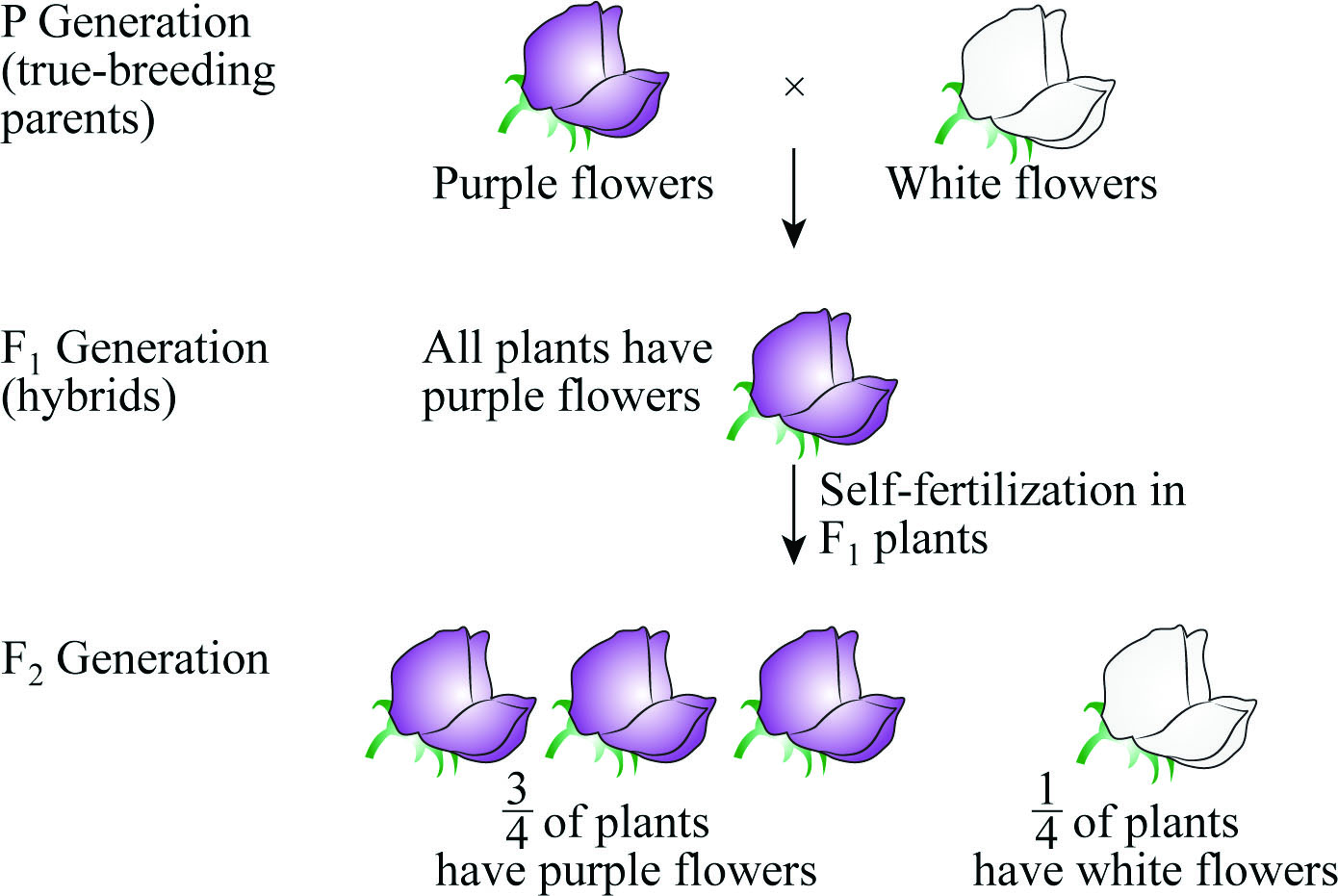
Concept explainers
When Mendel did crosses of true-breeding purple- and white-flowered pea plants, the white-flowered trait disappeared from the F1. generation but reappeared in the F2 generation. Use genetic terms to explain why that happened.
To explain: Why the white color trait disappeared in the F1 generation and was again observed in the F2 generation in Mendel’s cross between purple- and white- flowered pea plants.
Introduction: Genes have alternate forms known as alleles, which are transmitted to offspring. If the two alleles are different, then there is a hybrid in the F1 generation. The dominant allele out of the two expresses itself and determines the phenotype. In F1 individuals, two different alleles segregate into gametes. During self-pollination, the gametes unite randomly, thereby giving a chance to recessive alleles to be expressed in a homozygous state at the F2 generation.
Explanation of Solution
The cross between the individuals that are true breeding homozygous for one allele gives different traits in F1 progeny. This is called as monohybrid cross. Several traits of pea plants were studied in which Mendel used the purple- and white-colored flower traits to perform monohybrid experiment. When Mendel crossed these plants, the F1 hybrids or first true breeding generation received was both dominant and recessive alleles equally but showed a purple pigment. This is because the purple-colored trait was dominant over white. That is, white-colored trait is and was not expressed recessive in the F1 generation. However, the white trait was expressed in F2 generation of the experiment. This was because it is only possible for a white allele to exist in a homozygous state, which causes the white trait to be expressed in F2 generation.
Pictorial representation: Fig.1 shows Mendel’s cross between purple- and white-flowered pea plants.

Fig.1: Mendel’s cross between purple- and white-flowered pea plants
Want to see more full solutions like this?
Chapter 14 Solutions
Campbell Biology Custom Stony Brook 10 Th Edition
Additional Science Textbook Solutions
Chemistry: Structure and Properties (2nd Edition)
Human Biology: Concepts and Current Issues (8th Edition)
Genetic Analysis: An Integrated Approach (3rd Edition)
Organic Chemistry (8th Edition)
Microbiology: An Introduction
Anatomy & Physiology (6th Edition)
- Briefly state the physical meaning of the electrocapillary equation (Lippman equation).arrow_forwardExplain in a small summary how: What genetic information can be obtained from a Punnet square? What genetic information cannot be determined from a Punnet square? Why might a Punnet Square be beneficial to understanding genetics/inheritance?arrow_forwardIn a small summary write down:arrow_forward
- Not part of a graded assignment, from a past midtermarrow_forwardNoggin mutation: The mouse, one of the phenotypic consequences of Noggin mutationis mispatterning of the spinal cord, in the posterior region of the mouse embryo, suchthat in the hindlimb region the more ventral fates are lost, and the dorsal Pax3 domain isexpanded. (this experiment is not in the lectures).a. Hypothesis for why: What would be your hypothesis for why the ventral fatesare lost and dorsal fates expanded? Include in your answer the words notochord,BMP, SHH and either (or both of) surface ectoderm or lateral plate mesodermarrow_forwardNot part of a graded assignment, from a past midtermarrow_forward
 Biology Today and Tomorrow without Physiology (Mi...BiologyISBN:9781305117396Author:Cecie Starr, Christine Evers, Lisa StarrPublisher:Cengage Learning
Biology Today and Tomorrow without Physiology (Mi...BiologyISBN:9781305117396Author:Cecie Starr, Christine Evers, Lisa StarrPublisher:Cengage Learning Human Heredity: Principles and Issues (MindTap Co...BiologyISBN:9781305251052Author:Michael CummingsPublisher:Cengage Learning
Human Heredity: Principles and Issues (MindTap Co...BiologyISBN:9781305251052Author:Michael CummingsPublisher:Cengage Learning Concepts of BiologyBiologyISBN:9781938168116Author:Samantha Fowler, Rebecca Roush, James WisePublisher:OpenStax College
Concepts of BiologyBiologyISBN:9781938168116Author:Samantha Fowler, Rebecca Roush, James WisePublisher:OpenStax College Biology 2eBiologyISBN:9781947172517Author:Matthew Douglas, Jung Choi, Mary Ann ClarkPublisher:OpenStax
Biology 2eBiologyISBN:9781947172517Author:Matthew Douglas, Jung Choi, Mary Ann ClarkPublisher:OpenStax Human Biology (MindTap Course List)BiologyISBN:9781305112100Author:Cecie Starr, Beverly McMillanPublisher:Cengage Learning
Human Biology (MindTap Course List)BiologyISBN:9781305112100Author:Cecie Starr, Beverly McMillanPublisher:Cengage Learning Biology: The Dynamic Science (MindTap Course List)BiologyISBN:9781305389892Author:Peter J. Russell, Paul E. Hertz, Beverly McMillanPublisher:Cengage Learning
Biology: The Dynamic Science (MindTap Course List)BiologyISBN:9781305389892Author:Peter J. Russell, Paul E. Hertz, Beverly McMillanPublisher:Cengage Learning





